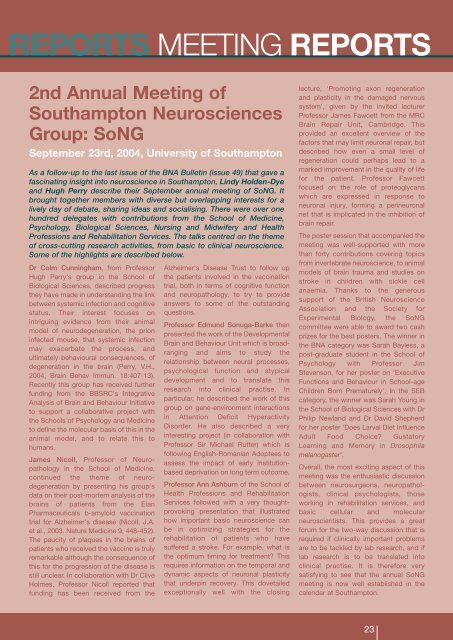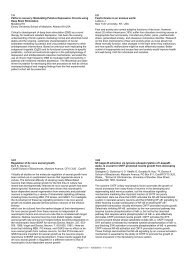a newsletter for members of the BNA - British Neuroscience ...
a newsletter for members of the BNA - British Neuroscience ...
a newsletter for members of the BNA - British Neuroscience ...
You also want an ePaper? Increase the reach of your titles
YUMPU automatically turns print PDFs into web optimized ePapers that Google loves.
REPORTS MEETING REPORTS<br />
2nd Annual Meeting <strong>of</strong><br />
Southampton <strong>Neuroscience</strong>s<br />
Group: SoNG<br />
September 23rd, 2004, University <strong>of</strong> Southampton<br />
As a follow-up to <strong>the</strong> last issue <strong>of</strong> <strong>the</strong> <strong>BNA</strong> Bulletin (issue 49) that gave a<br />
fascinating insight into neuroscience in Southampton, Lindy Holden-Dye<br />
and Hugh Perry describe <strong>the</strong>ir September annual meeting <strong>of</strong> SoNG. It<br />
brought toge<strong>the</strong>r <strong>members</strong> with diverse but overlapping interests <strong>for</strong> a<br />
lively day <strong>of</strong> debate, sharing ideas and socialising. There were over one<br />
hundred delegates with contributions from <strong>the</strong> School <strong>of</strong> Medicine,<br />
Psychology, Biological Sciences, Nursing and Midwifery and Health<br />
Pr<strong>of</strong>essions and Rehabilitation Services. The talks centred on <strong>the</strong> <strong>the</strong>me<br />
<strong>of</strong> cross-cutting research activities, from basic to clinical neuroscience.<br />
Some <strong>of</strong> <strong>the</strong> highlights are described below.<br />
Dr Colm Cunningham, from Pr<strong>of</strong>essor<br />
Hugh Perry's group in <strong>the</strong> School <strong>of</strong><br />
Biological Sciences, described progress<br />
<strong>the</strong>y have made in understanding <strong>the</strong> link<br />
between systemic infection and cognitive<br />
status. Their interest focuses on<br />
intriguing evidence from <strong>the</strong>ir animal<br />
model <strong>of</strong> neurodegeneration, <strong>the</strong> prion<br />
infected mouse, that systemic infection<br />
may exacerbate <strong>the</strong> process, and<br />
ultimately behavioural consequences, <strong>of</strong><br />
degeneration in <strong>the</strong> brain (Perry, V.H.,<br />
2004, Brain Behav Immun. 18:407-13).<br />
Recently this group has received fur<strong>the</strong>r<br />
funding from <strong>the</strong> BBSRC's Integrative<br />
Analysis <strong>of</strong> Brain and Behaviour Initiative<br />
to support a collaborative project with<br />
<strong>the</strong> Schools <strong>of</strong> Psychology and Medicine<br />
to define <strong>the</strong> molecular basis <strong>of</strong> this in <strong>the</strong><br />
animal model, and to relate this to<br />
humans.<br />
James Nicoll, Pr<strong>of</strong>essor <strong>of</strong> Neuropathology<br />
in <strong>the</strong> School <strong>of</strong> Medicine,<br />
continued <strong>the</strong> <strong>the</strong>me <strong>of</strong> neurodegeneration<br />
by presenting his group's<br />
data on <strong>the</strong>ir post-mortem analysis <strong>of</strong> <strong>the</strong><br />
brains <strong>of</strong> patients from <strong>the</strong> Elan<br />
Pharmaceuticals b-amyloid vaccination<br />
trial <strong>for</strong> Alzheimer's disease (Nicoll, J.A.<br />
et al., 2003. Nature Medicine 9, 448-452).<br />
The paucity <strong>of</strong> plaques in <strong>the</strong> brains <strong>of</strong><br />
patients who received <strong>the</strong> vaccine is truly<br />
remarkable although <strong>the</strong> consequence <strong>of</strong><br />
this <strong>for</strong> <strong>the</strong> progression <strong>of</strong> <strong>the</strong> disease is<br />
still unclear. In collaboration with Dr Clive<br />
Holmes, Pr<strong>of</strong>essor Nicoll reported that<br />
funding has been received from <strong>the</strong><br />
Alzheimer's Disease Trust to follow up<br />
<strong>the</strong> patients involved in <strong>the</strong> vaccination<br />
trial, both in terms <strong>of</strong> cognitive function<br />
and neuropathology, to try to provide<br />
answers to some <strong>of</strong> <strong>the</strong> outstanding<br />
questions.<br />
Pr<strong>of</strong>essor Edmund Sonuga-Barke <strong>the</strong>n<br />
presented <strong>the</strong> work <strong>of</strong> <strong>the</strong> Developmental<br />
Brain and Behaviour Unit which is broadranging<br />
and aims to study <strong>the</strong><br />
relationship between neural processes,<br />
psychological function and atypical<br />
development and to translate this<br />
research into clinical practise. In<br />
particular, he described <strong>the</strong> work <strong>of</strong> this<br />
group on gene-environment interactions<br />
in Attention Deficit Hyperactivity<br />
Disorder. He also described a very<br />
interesting project (in collaboration with<br />
Pr<strong>of</strong>essor Sir Michael Rutter) which is<br />
following English-Romanian Adoptees to<br />
assess <strong>the</strong> impact <strong>of</strong> early institutionbased<br />
deprivation on long term outcome.<br />
Pr<strong>of</strong>essor Ann Ashburn <strong>of</strong> <strong>the</strong> School <strong>of</strong><br />
Health Pr<strong>of</strong>essions and Rehabilitation<br />
Services followed with a very thoughtprovoking<br />
presentation that illustrated<br />
how important basic neuroscience can<br />
be in optimizing strategies <strong>for</strong> <strong>the</strong><br />
rehabilitation <strong>of</strong> patients who have<br />
suffered a stroke. For example, what is<br />
<strong>the</strong> optimum timing <strong>for</strong> treatment? This<br />
requires in<strong>for</strong>mation on <strong>the</strong> temporal and<br />
dynamic aspects <strong>of</strong> neuronal plasticity<br />
that underpin recovery. This dovetailed<br />
exceptionally well with <strong>the</strong> closing<br />
lecture, 'Promoting axon regeneration<br />
and plasticity in <strong>the</strong> damaged nervous<br />
system', given by <strong>the</strong> invited lecturer<br />
Pr<strong>of</strong>essor James Fawcett from <strong>the</strong> MRC<br />
Brain Repair Unit, Cambridge. This<br />
provided an excellent overview <strong>of</strong> <strong>the</strong><br />
factors that may limit neuronal repair, but<br />
described how even a small level <strong>of</strong><br />
regeneration could perhaps lead to a<br />
marked improvement in <strong>the</strong> quality <strong>of</strong> life<br />
<strong>for</strong> <strong>the</strong> patient. Pr<strong>of</strong>essor Fawcett<br />
focused on <strong>the</strong> role <strong>of</strong> proteoglycans<br />
which are expressed in response to<br />
neuronal injury, <strong>for</strong>ming a perineuronal<br />
net that is implicated in <strong>the</strong> inhibition <strong>of</strong><br />
brain repair.<br />
The poster session that accompanied <strong>the</strong><br />
meeting was well-supported with more<br />
than <strong>for</strong>ty contributions covering topics<br />
from invertebrate neuroscience, to animal<br />
models <strong>of</strong> brain trauma and studies on<br />
stroke in children with sickle cell<br />
anaemia. Thanks to <strong>the</strong> generous<br />
support <strong>of</strong> <strong>the</strong> <strong>British</strong> <strong>Neuroscience</strong><br />
Association and <strong>the</strong> Society <strong>for</strong><br />
Experimental Biology, <strong>the</strong> SoNG<br />
committee were able to award two cash<br />
prizes <strong>for</strong> <strong>the</strong> best posters. The winner in<br />
<strong>the</strong> <strong>BNA</strong> category was Sarah Bayless, a<br />
post-graduate student in <strong>the</strong> School <strong>of</strong><br />
Psychology with Pr<strong>of</strong>essor Jim<br />
Stevenson, <strong>for</strong> her poster on 'Executive<br />
Functions and Behaviour in School-age<br />
Children Born Prematurely'. In <strong>the</strong> SEB<br />
category, <strong>the</strong> winner was Sarah Young in<br />
<strong>the</strong> School <strong>of</strong> Biological Sciences with Dr<br />
Philip Newland and Dr David Shepherd<br />
<strong>for</strong> her poster 'Does Larval Diet Influence<br />
Adult Food Choice? Gustatory<br />
Learning and Memory in Drosophila<br />
melanogaster'.<br />
Overall, <strong>the</strong> most exciting aspect <strong>of</strong> this<br />
meeting was <strong>the</strong> enthusiastic discussion<br />
between neurosurgeons, neuropathologists,<br />
clinical psychologists, those<br />
working in rehabilitation services, and<br />
basic cellular and molecular<br />
neuroscientists. This provides a great<br />
<strong>for</strong>um <strong>for</strong> <strong>the</strong> two-way discussion that is<br />
required if clinically important problems<br />
are to be tackled by lab research, and if<br />
lab research is to be translated into<br />
clinical practise. It is <strong>the</strong>re<strong>for</strong>e very<br />
satisfying to see that <strong>the</strong> annual SoNG<br />
meeting is now well established in <strong>the</strong><br />
calendar at Southampton.<br />
23
















